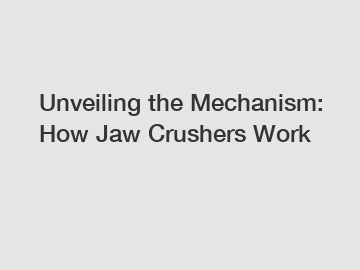Chunlei contains other products and information you need, so please check it out.
Unveiling the Mechanism: How Jaw Crushers Work.
Jaw crushers are a key piece of equipment in crushing materials for various industries such as mining, construction, and demolition. Understanding how jaw crushers work can help to optimize performance and ensure efficient operation. In this article, we will delve into the mechanism of jaw crushers and explore the key components that make them work effectively.

Function of Jaw Crushers.
Jaw crushers are designed to break down large rocks into smaller, more manageable pieces. They achieve this by applying compressive force to the material, which causes the rocks to break apart. The primary function of a jaw crusher is to reduce the size of the material by applying pressure between two surfaces. The movable jaw exerts force on the rock while the fixed jaw holds the material in place.
The Crushing Process.
The crushing process in a jaw crusher begins with the material being fed into the machine through the top of the jaws. As the material moves down the jaws, it is crushed between the two surfaces. The movement of the jaws creates a squeezing motion, which breaks the rocks into smaller pieces. The crushed material then exits the jaw crusher through a discharge opening at the bottom.
Key Components of Jaw Crushers.
1. Jaw Plates: The jaw plates are the main components of a jaw crusher that come into direct contact with the material being crushed. They are typically made of manganese steel, which is known for its high impact resistance and durability. The design and size of the jaw plates play a crucial role in determining the capacity and efficiency of the jaw crusher.
2. Eccentric Shaft: The eccentric shaft is a critical component that drives the movement of the jaws in a jaw crusher. It is responsible for converting the rotational motion of the motor into a reciprocating motion, which then moves the jaws back and forth. The eccentric shaft is usually made of high-grade steel to withstand the heavy loads and stresses encountered during the crushing process.
3. Toggle Plate: The toggle plate is a small component that plays a significant role in the operation of a jaw crusher. It acts as a safety device, protecting the jaw crusher from overloading and preventing damage to the crusher. The toggle plate also allows for the adjustment of the discharge opening, which affects the size of the crushed material.
Optimizing Jaw Crusher Performance.
To ensure optimal performance of a jaw crusher, it is essential to regularly inspect and maintain key components such as the jaw plates, eccentric shaft, and toggle plate. Routine maintenance tasks, such as lubrication, tightening bolts, and replacing worn parts, can help to prolong the lifespan of the crusher and prevent costly downtime.
Conclusion.
In conclusion, jaw crushers are essential equipment for crushing a wide range of materials in various industries. By understanding the mechanism of jaw crushers and the key components that make them work effectively, operators can optimize performance and ensure efficient operation. Regular maintenance and proper care of jaw crushers are crucial to maximizing their lifespan and productivity.
Contact us to learn more about jaw crushers and how they can benefit your operations.
If you want to learn more, please visit our website.
If you are looking for more details, kindly visit jaw rock crusher.




Comments
Please Join Us to post.
0